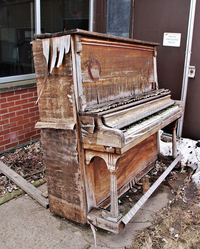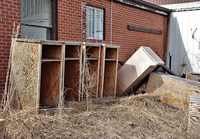Harry S. Truman once said, “Men make history and not the other way around. In periods where there is no leadership, society stands still. Progress occurs when courageous, skillful leaders seize the opportunity to change things for the better.”
In 1993 Youth Services International (YSI), a leading national provider of private educational, developmental and rehabilitative programs to adjudicated juveniles, purchased the facility that locals know as Springfield Academy in Springfield, South Dakota.
Springfield Academy closed its doors in late January of 2011.
The true story doesn’t lie in this closed-down facility for juveniles or the tainted past it had in the community of Springfield, but in the history of what this site was for centuries before, St. Mary’s Episcopal School for Indian Girls, the oldest Indian school for girls in America. And in understanding the legacy of this school, I must share the history of two very important people who devoted a large
portion of their life to the school. Their lives and journey are truly awe inspiring. Kenyon and Prisca Cull overcame insurmountable obstacles, but their lives encompassed determination, courage, dedication, vision and unwavering faith.
Prisca Cull was the daughter of Abdul Ahad and Meleki Wazir, extremely well-to-do Assyrian landowners, who lived in Turkey. They were Roman Catholics who owned many farms and who became objects of the genocide that prevailed after Mustafa Kemal (Ataturk, or Father of the Turks) set up the Republic of Turkey in 1923.
The day of Prisca’s birth, June 7, 1924, she was rescued in great haste and secrecy by a Christian missionary from Mardin, Turkey, Agnes Fenenga. At the time of Prisca’s birth her father was murdered and their property confiscated. Her mother, overcome by the family tragedy, succumbed in childbirth, and a twin brother also did not survive. Because Prisca was the heiress to the many farms that had been commandeered, her life was in absolute and constant peril.
Prisca always thought of Agnes Fenenga as her adopted mother and till her death referred to her in that light. Prisca’s early life was spent in the Congregational Mission to Turkey at Mardin, a small interior town that was virtually isolated from the rest of the country. Written communications to the outside world were permitted only in Turkish. Life at the Mission, although isolated, was comfortable. There were no cars, only horses. There was a swimming pool, beautiful gardens and a good home.
At the age of 11 in 1935, Prisca was sent to the American Friends School for Girls at Ramallah, Palestine, where she received an excellent education with students who were mostly Arabic speaking. There she finished high school at the age of 17 in 1940. After high school, Prisca went to Bermul and graduated from the British Syrian Training College as a teacher in 1943. Prisca they took a teaching position at the British Friends School for Boys in Broumana, Lebanon, where she taught kindergarten, the only woman on the staff. The students spoke English, Arabic, French and Armenian. In 1943 Prisca went home for Christmas to Aleppo to be with her mother Agnes, and met Kenyon Cull, a British soldier in the Signal Corps, at an Armenian church.
Kenyon was born on July 1, 1920, at Standlake, Oxfordshire, England to Frank and Florence Cull. He and his siblings attended Whitney Grammar School, and rode their bicycles daily six miles to school and back in every kind of weather. Kenyon graduated from the Reading School (founded in 1105) in 1937. He then attended the Reading University, majoring in history and planning to teach for two years before being called into military service in 1940 during World War II. Kenyon’s service years took him through the British involvement in North Africa all the way to the shattering of Nazi control at Alamein in 1942. He was serving in the Signal Corps with the largest armored division ever assembled, and after Alamein he was sent to Cairo, Egypt. On December 31, 1942, his group left Cairo, travelled through the Sinai Desert to Palestine, across Lebanon to Damascus, and on to Aleppo in Syria. The British were concerned about the possibility of Turkey intervening on the Axis’ side. One Sunday morning in January, Kenyon went to the Armenian Church in Aleppo and he and his two buddies were invited to visit the home of three American missionary ladies that evening, one of those ladies was Agnes Fenenga. They were invited regularly on Thursday and Sunday evenings, Kenyon stated, “The house was a large, comfortable, three-story residential home. There were usually several soldiers present. We talked, had cookies and tea, sang a few hymns, read from the scriptures and said a few prayers.” On one of these occasions, Prisca, who was home for Christmas
holiday, and Kenyon were introduced. Kenyon said, “Everything that we have done was influenced by the church, Prisca was rescued by the church, we met through the church, we served the church as teachers and the church has been a key part of our lives.”
Within weeks of meeting Prisca and corresponding with each other by letters, he volunteered to go on a special assignment in Cairo. “This was the beginning of a great opportunity for me and Prisca. It was a semi civilian post in the communication center of the entire British nation, where we kept in touch with all of our embassies the world over. General Headquarters in Cairo was all ‘spit and polish.’ There soon was an opportunity for assignment in Jerusalem, which I jumped on. The office was on the top of the King David Hotel. We had our own apartment and special passes. The beauty of it was that I was able to continue my correspondence with Prisca and Jerusalem was not far from Prisca’s school. Passes were easy to obtain and one could hitch-hike on army vehicles through Haifa to Beirut. Sometimes I walked the last five miles.”
“We were engaged in Ramallah on November 2, 1944, on the rooftop of the home of a mathematics teacher. He put it out on the loudspeaker, and everyone came out and congratulated us. When the war ended, we wanted to make application to be married. This was a risky thing. For justifiable reasons, the government protected the country from the influx of ‘war brides’ and some soldiers, making application, suddenly found themselves stationed in another part of the world.” Because Prisca had obtained a teaching job at Ramallah, the American Friends School for Girls, this made it easier for them to get married.
Kenyon stated, “We were married in Christ Church in Jerusalem (in the old city on the site of Herod’s palace), a beautiful church.
The Cull’s honeymoon was to be spent at a monastery guest house on the Sea of Galilee, a breathtaking spot. And it had snowed, a rare happening in that part of the world. So, the couple stayed in Jerusalem for three days.
Soon afterward, Kenyon was re-assigned to Cairo. Later Prisca joined him, and they returned to
England on an ocean liner, the Mauritania. Kenyon returned to the land of his birth after 6 years, with his new bride. The newlyweds lived with his mother and Prisca taught kindergarten to 56 youngsters, while Kenyon went back to college. He took an accelerated course at Newland Park Teachers College, thirty miles from Reading, England, riding a motorized bicycle, and coming home on the weekends. “The great thing about Newland Park was the incredible emphasis that was placed on teaching methods. There were some great professors. We had no vacations. You practiced/taught at every level; kindergarten through sixth grade, middle and high school. Some of the classes contained highly accelerated, talented students. At one time, when the Divinity professor was ill, the authorities asked me to teach, a great experience.” Kenyon would tell. He gained invaluable experience when asked to teach at an all-girls school, and when he finally finished his college training at Newland Park, in 1949, he was hired to teach history at an English high school. In 1950, Kenyon and Prisca welcomed their first child, a daughter they named Joy. Kenyon continued to teach untill 1951. During that time, the Cull’s had friends from Yankton, South Dakota, come to visit, who had known Prisca’s mother Agnes, and they heavily influenced the Cull’s to come to Yankton.
Because their pay was low and expenses high, and because Kenyon wanted the credentials of a degree that Yankton College had to offer, the Cull’s came to Yankton for the fall semester. In one year and a summer, taking a 60 hour load, Kenyon completed his course work at Yankton College, with honors, in July of 1952. That fall, Kenyon was asked to teach at the Yankton Central School. He did this for three years while working on a master’s degree at the University of South Dakota.
In 1955, the Bishop of the Diocese asked Kenyon to come visit the St. Mary’s Girls School at Springfield, South Dakota. He was asked to spend a year there to make recommendations on whether to continue or close the school. Because Kenyon was waiting on a pending fellowship for further graduate study at Michigan University, he agreed to do so. The same year, Kenyon was appointed Headmaster and Prisca ended up overseeing many of the school’s operations. There were 21 students and the main building was run down, a chalk stone affair erected in 1884. There were two staff members, and the conditions were such that there seemed no possibility of the school continuing.
Fate stepped into the picture the following year. Kenyon was interviewed for a Woodrow Wilson Fellowship in Lincoln, Nebraska, and because of a technicality, he was unable to receive it. So the Culls took up the task of building facilities, adding faculty and staff, increasing enrollment and developing a level 1 accredited institution. In 1960 Kenyon and Prisca welcomed a son they named Bruce.
The Daughters of the American Revolution and Episcopal Church were allies that made the Cull’s efforts possible. Kenyon’s philosophy mandated that St. Mary’s be a school where excellence was number one: excellence in scholarship and character. The school provided an outstanding library, orderly clean dormitory living, modern teaching equipment including computers, a piano in every classroom, an outstanding food service, a marvelous chapel and a dedicated faculty and staff. Students who attended the school were tested and interviewed before being admitted. Discipline was firm and fair, each class adopted a distinctive dress uniform, athletics were an important part of student life, and the percentage of students continuing on for more education after high school was high. For a number of years, the St. Mary’s Summer Home Program allowed many of the girls spent the summer in carefully selected homes throughout the country.
The Culls ended up staying at St. Mary’s for 29 productive years. In 1985, Kenyon resigned to become Director of Development, then retired in Yankton in 1987. In July of 1993, at the age of 69, Prisca passed away and at the age of 90, Kenyon passed away on June 21, 2011.
A big thank you to Bruce Cull for providing me with the history of his parent’s courageous journey, Kenyon was a true Christian missionary and would put helping others first, always.
Writing this column has taken me on a journey of sorts, I never expected to get comments from time to time and it is humbling. Want to share your thoughts, feelings or even have a story idea; I would love to hear from you. Please email me, ang@yankton.net, and thanks for reading! Ang






